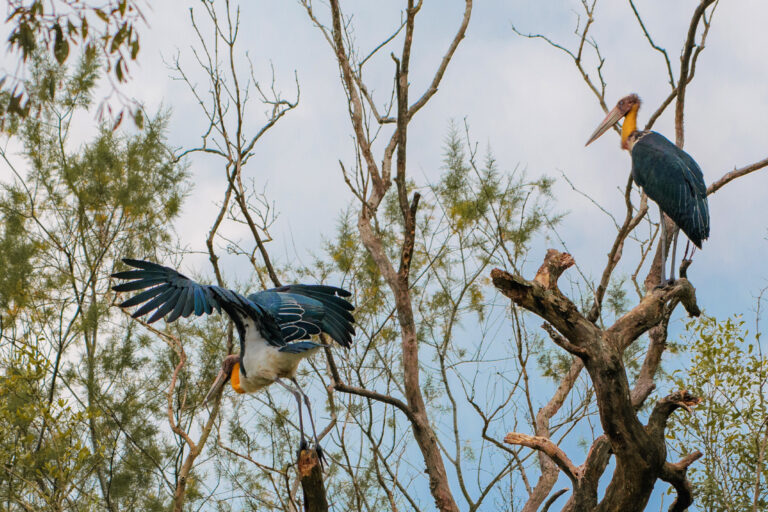- A recent fire in the eastern Sundarbans of Bangladesh has highlighted the rising risk of burning in the world’s biggest mangrove forest.
- The Bangladesh government says it’s drawing up guidelines to address the problem, which is attributed largely to human activity.
- A major factor for the fire risk is the drying out of the creeks and canals that crisscross through the Sundarbans, a consequence of embankments that were built to keep out seawater but that have also led to the buildup of river-borne silt.
- In 2022, Bangladesh began imposing a three-month ban, from June through August, on people entering the Sundarbans, but the policy has been widely criticized as unfair.
The Bangladesh government is drafting guidelines to tackle the rising incidence of fires in the Sundarbans, the world’s largest mangrove forest, as intensifying human activity raises the risk of burning in the region.
“We have already decided to formulate an SOP [standard operating procedure] which will act as a guideline for all stakeholders, including forest officials, forest-dependent communities, and tourists,” Saber Hossain Chowdhury, Bangladesh’s environment minister, told Mongabay on May 12, 2024.
He said his office also plans to conduct an awareness-building program for about 3.5 million forest-dependent people on how to collect resources from the mangrove forest sustainably.
The announcement coincided with the latest fire incident in the Sundarbans. It took personnel from the fire department, coast guard, forest guard and other government agencies two days to put out a blaze that began on May 4 in the Amarbunia area of Bagerhat district, in the eastern Sundarbans. In all, the fire swept through 3.2 hectares (7.9 acres) of mangroves, damaging 2 hectares (5 acres), according to a statement from the environment ministry.

Fires of this extent aren’t new in this biodiverse coastal ecosystem, and they’re largely caused by humans, whether deliberately or accidentally. A 2021 study showed 24 fire incidents recorded in the Bangladeshi Sundarbans from 2001 to 2021, but said the real number was likely much higher.
It attributed the accidental causes to people discarding cigarette butts or carrying lit torches as they gather wood, fish, or collect honey. The study said fires are also set on purpose to clear land for livestock grazing, to smoke out mud-dwelling fish in shallow channels of water, and even to misdirect the attention of authorities from hunting activities.
What’s exacerbating the risk of fire is the fact that many of the creeks and canals that crisscross the Sundarbans are silting up and drying out. That allows a thick carpet of dry leaf litter to build up on the forest floor — the ideal kindling for a fire sparked by a lit cigarette.
Researchers and officials attribute the silting problem to embankments built along the mud flats to protect local communities from rising sea levels. These embankments have also worked in the opposite direction, however, preventing the silt carried downriver by the Ganga and its tributaries from washing out to sea. The buildup of silt has over time raised the level of streambeds, effectively extinguishing patches of the Sundarbans’ web of water.
“It is believed that embankments have altered the hydrodynamics network, sediment accretion and erosion pattern in the Sundarbans, which may alter the rate of sea level rise. In many cases, the creek beds (surrounding the Sundarbans) have risen higher than the low-lying areas behind the embankments,” the 2021 study found.


“Water cannot enter many parts of the forest [due to the elevation],” Mihir Kumar Doe, forest conservator for the Khulna region, said as quoted by The Daily Star. “The ecology of the area is changing because of the irregular water access. Not only the riverbeds, but even the forest ground has risen.
“The dry leaves accumulated on the ground have rotted and formed a layer that is between an inch and a foot thick, which can fuel fires,” he added.
Construction of the embankments goes back about 200 years, and in that time they’ve influenced water flows in the Sundarbans “at the regional scale,” according to the 2021 study. But they’re just one of the myriad human factors putting pressure on the mangrove forest. In 2022, the Bangladesh government announced a ban on people entering the Sundarbans from July through August each year, citing the need to minimize disruptions to wildlife during the breeding season.
The policy has since been widely criticized as unfairly cutting off forest-dependent communities while failing to compensate them for the loss of their livelihoods or present them with alternatives.
The Sundarbans straddle Bangladesh and India in the Bay of Bengal, spanning a total area of around 10,200 square kilometers (3,900 square miles). The Bangladesh portion of the mangrove forest measures 6,017 km2 (2,323 mi2), according to the Forest Department, accounting for 4% of the country’s total land area and 40% of its forests. Three wildlife sanctuaries on the Bangladesh side — Sundarbans East, Sundarbans West and Sundarbans South — are listed as UNESCO World Heritage Sites, hosting more than 450 animal and 330 plant species.
Banner image: A pair of lesser adjutants in the Sundarbans. Image by Sagar via Flickr (CC BY 2.0).
Bangladesh ban on resource hunting in Sundarbans leaves communities facing hardship
Citation:
Mahmood, H., Ahmed, M., Islam, T., Uddin, M. Z., Ahmed, Z. U., & Saha, C. (2021). Paradigm shift in the management of the Sundarbans mangrove forest of Bangladesh: Issues and challenges. Trees, Forests and People, 5, 100094. doi:10.1016/j.tfp.2021.100094

